Pisa is a city and comune in Tuscany, central Italy, straddling the Arno just before it empties into the Ligurian Sea. It is the capital city of the Province of Pisa. Although Pisa is known worldwide for its leaning tower, the city contains more than twenty other historic churches, several medieval palaces, and bridges across the Arno. Much of the city’s architecture was financed from its history as one of the Italian maritime republics.
The city is also home to the University of Pisa, which has a history going back to the 12th century, the Scuola Normale Superiore di Pisa, founded by Napoleon in 1810, and its offshoot, the Sant’Anna School of Advanced Studies.
The most believed hypothesis is that the origin of the name Pisa comes from Etruscan and means ‘mouth’, as Pisa is at the mouth of the Arno river.
Although throughout history there have been several uncertainties about the origin of the city of Pisa, excavations made in the 1980s and 1990s found numerous archaeological remains, including the fifth century BC tomb of an Etruscan prince, proving the Etruscan origin of the city, and its role as a maritime city, showing that it also maintained trade relations with other Mediterranean civilizations.
Ancient Roman authors referred to Pisa as an old city. Virgil, in his Aeneid, states that Pisa was already a great center by the times described; and gives the epithet of Alphēae to the city because it was said to have been founded by colonists from Pisa in Elis, near which the Alpheius river flowed. The Virgilian commentator Servius wrote that the Teuti founded the town 13 centuries before the start of the common era.
1.The Leaning Tower of Pisa

The Leaning Tower of Pisa or simply, the Tower of Pisa is the campanile, or freestanding bell tower, of Pisa Cathedral. It is known for its nearly four-degree lean, the result of an unstable foundation. The tower is one of three structures in the Pisa’s Cathedral Square (Piazza del Duomo), which includes the cathedral and Pisa Baptistry.
The height of the tower is 55.86 metres (183 feet 3 inches) from the ground on the low side and 56.67 m (185 ft 11 in) on the high side. The width of the walls at the base is 2.44 m (8 ft 0 in). Its weight is estimated at 14,500 tonnes (16,000 short tons).The tower has 296 or 294 steps; the seventh floor has two fewer steps on the north-facing staircase.
The tower began to lean during construction in the 12th century, due to soft ground which could not properly support the structure’s weight. It worsened through the completion of construction in the 14th century. By 1990, the tilt had reached 5.5 degrees. The structure was stabilized by remedial work between 1993 and 2001, which reduced the tilt to 3.97 degrees.
Every child has heard of it, and every visitor to Pisa probably heads first to what is undoubtedly the world’s most famous tower: La Torre Pendente, the leaning campanile standing next to the cathedral.
The foundation stone was laid in 1173, when Pisa was Italy’s most powerful maritime republic, and its loggia-like tiers were modeled after the cathedral facade. Even before the third story was completed, the tower had already begun to sink alarmingly on its south side. When counterweighting the north side and slightly increasing the height of the south walls proved ineffective, construction was halted.
Almost 100 years later, work resumed, attempting to counteract the tilt by angling the upper stories more towards the vertical. The open bell-chamber was added to the white marble tower in 1350-72, by Tommaso Pisano.
2.Cathedral of Santa Maria Assunta
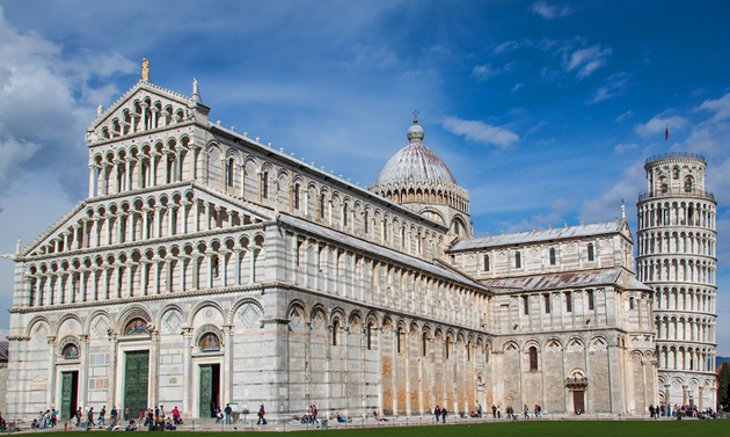
The Church of Santa Maria Assunta (basilica di Santa Maria Assunta) is a basilica church on the island of Torcello, Venice, northern Italy. It is a notable example of Late Paleochristian architecture, one of the most ancient religious edifices in the Veneto, and containing the earliest mosaics in the area of Venice.
According to an ancient inscription, it was founded by the exarch Isaac of Ravenna in 639, when Torcello was still a rival to the young nearby settlement at Venice.
The original church is believed to have had a nave with one aisle on each side and a single apse on the eastern wall of the cathedral. It’s difficult to tell what the original church was like because very little of it survived the subsequent renovations. Much of the plan of the original church survives as its present form is very similar to the original but the only physical parts that survive are the central apse wall and part of the baptistery that survives as part of the façade of the current church.
The first of two major renovations occurred in 864 under the direction of Bishop Adeodatus II. In this renovation, the two aisle apses that appear today were built. Also, the synthronon that fills the central apse was created and the crypt was placed under it. After this renovation, the cathedral would have resembled the current cathedral more than the original church would have but it is not until after the second and final major renovation that the cathedral appears very similar to its current design.
The definitive example of the Pisan architectural style, the Cathedral of Santa Maria Assunta is a five-aisled Romanesque basilica of white marble designed by Pisan architect Buscheto. Begun in 1063, after Pisa’s naval victory over the Saracens, it was consecrated (still unfinished) in 1118, and towards the end of that century, a new west front was added and the main apse was completed.
3.Campo Santo (Sacred Field)
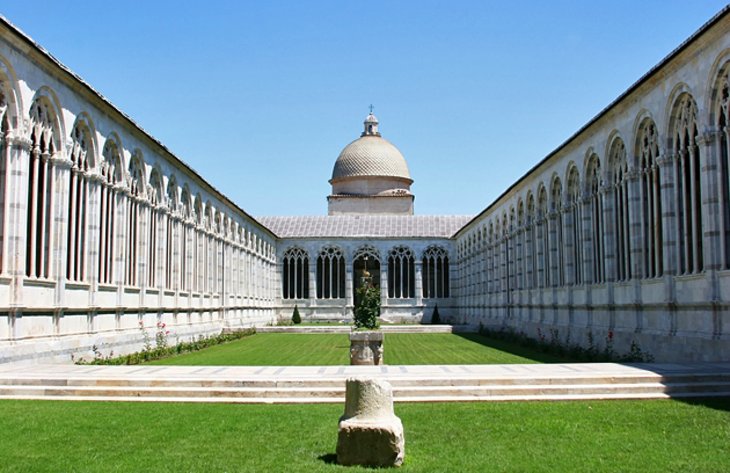
The Campo Santo, also known as Camposanto Monumentale (“monumental cemetery”) or Camposanto Vecchio (“old cemetery”), is a historical edifice at the northern edge of the Cathedral Square in Pisa, Italy.
“Campo Santo” can be literally translated as “holy field”, because it is said to have been built around a shipload of sacred soil from Golgotha, brought back to Pisa from the Third Crusade by Ubaldo Lanfranchi, archbishop of Pisa in the 12th century. A legend claims that bodies buried in that ground will rot in just 24 hours. The burial ground lies over the ruins of the old baptistery of the church of Santa Reparata, the church that once stood where the cathedral now stands.
The term “monumental” serves to differentiate it from the later-established urban cemetery in Pisa.
According to local legend, Archbishop Ubaldo dei Lanfranchi returned from the Fourth Crusade with several shiploads of earth from Golgotha, so that the citizens of Pisa could be buried in sacred soil. The construction of the Camposanto (Sacred Field) to hold it began in 1278, a large rectangular cloister whose gallery of arches decorated with Gothic tracery open into the courtyard.
On the floor of the cloister are the graves of Pisan patricians, and around the sides are Roman sarcophagi. The walls were covered with 14th- and 15th-century frescoes, but a fire caused by artillery bombardment in 1944 melted the lead roof, either destroying or badly damaging the frescoes.
4.Museo dell’Opera del Duomo (Cathedral Museum)
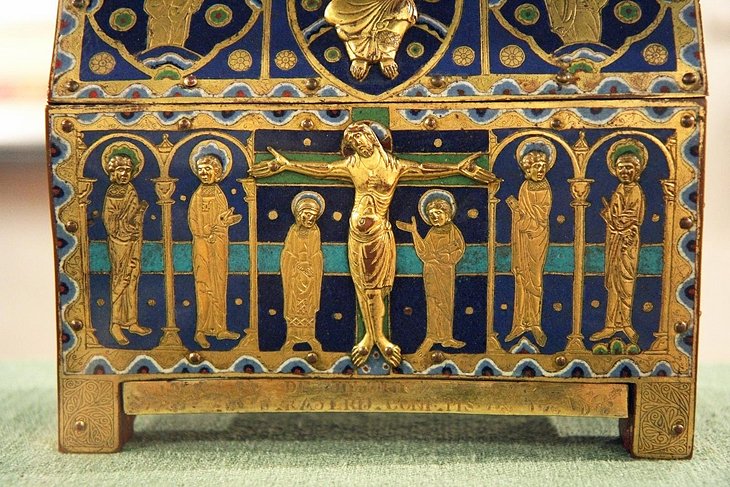
One of the best designed and curated museums in Tuscany is also one of the least-visited places on the Campo dei Miracoli, which is a shame because it adds enormously to an understanding of the art and craftsmanship of that era. And it has an added bonus for those who do explore it: a superb view of the Leaning Tower from the huge second-floor windows.
The cathedral’s museum houses its considerable treasury, which includes priceless masterworks of silversmiths, rich embroideries, tombs, sculpture, and paintings. Many of the sculptures once decorated various buildings of the complex, but were brought indoors for protection many years ago – before they were subject to modern atmospheric pollution, so they are in such good condition that they seem to have been created yesterday instead of centuries ago.
The Museo dell’Opera del Duomo (Museum of the Works of the Cathedral) in Florence, Italy is a museum containing many of the original works of art created for Florence Cathedral, including the adjacent Florence Baptistery and Giotto’s Campanile. Most of the exterior sculptures have been removed from these cathedral buildings, usually replaced by replica pieces, with the museum conserving the originals.
The museum is located just east of the Duomo, near its apse. It occupies the area where much of the sculpture it houses was originally carved, as well as pieces such as Michelangelo’s David, which was commissioned for the cathedral (this is now in the Galleria dell’Accademia).It opened as a museum in 1891, and now houses what has been called “one of the world’s most important collections of sculpture.
5. Murale Tuttomondo
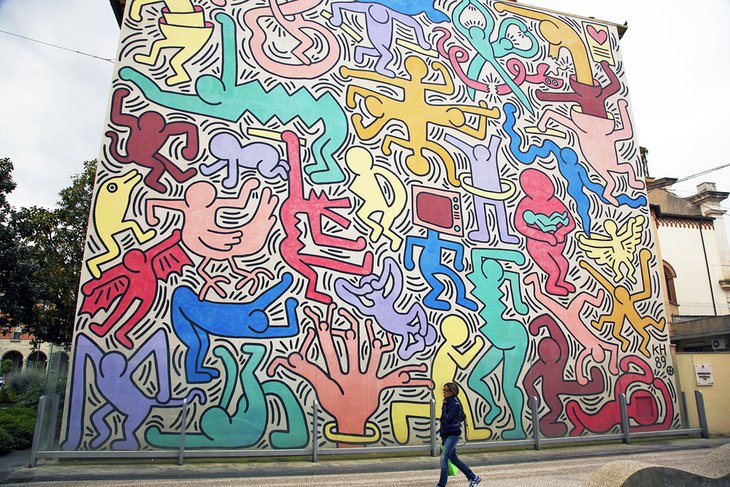
Tuttomondo (English: All World) is a mural created by American artist Keith Haring in 1989. Located on the rear wall of the Sant’Antonio Abate church in Pisa, it is one of the last public murals executed before his death from AIDS-related complications in 1990. It is also one of the few outdoor public works created by Haring for permanent display.
In 1989, after a chance encounter with a student from Pisa, artist Keith Haring was commissioned to paint a mural on the rear wall of Sant’Antonio Abate church. The resulting Tuttomondo (all the world) is one of the largest murals in Europe, at 180 square meters, and took Haring a week to complete.
Tuttomondo is one of only a few outdoor works created by Haring for permanent public display, and he later called it one of his most important. It was also to be one of his last. He completed only one other mural before his death in 1990 at age 31.
Thirty figures, painted in bright colors and in Haring’s cartoon style, seem to tumble across the wall. Women, men, children, a dolphin, a bat, and other animals mix together in an exuberant dance. Haring’s message of harmony and love between humans, animals, and nature is as relevant today as it was in 1989.
6.Arsenals & Museum of Ancient Ships
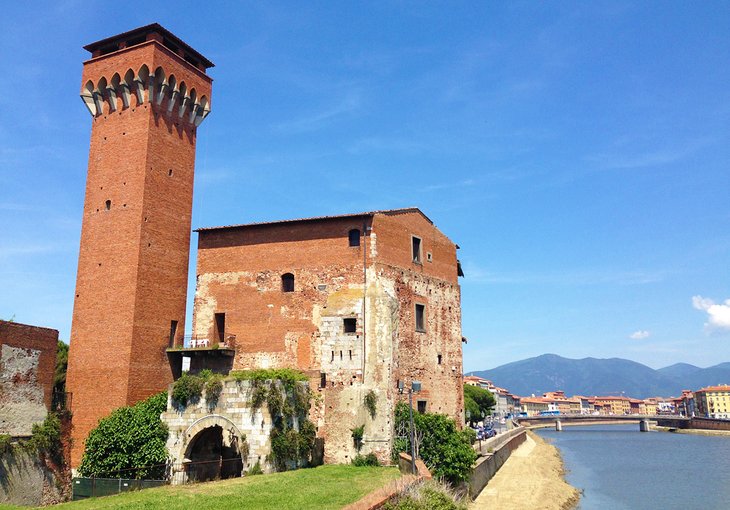
The Museum of Ancient Ships is a museum in Pisa, Tuscany, Italy. The museum exhibits ancient ships and artifacts. The exhibition space is within the ancient halls of the Medici Arsenals.
The Arsenals were built between 1548 and 1588 by Grand Duke Cosimo I de’ Medici to strengthen his naval power and revive the glory days of Pisa’s Maritime Republic. The large arcaded sheds were used to build 50-meter-long galleys, warships that were launched directly into the Arno.
The arsenals were built inside the Cittadella, which dates to 1160, but has only the San’Agnese tower still intact. The tall Guelfa Tower (which you can climb for sweeping views across Pisa and the Arno) was built in the early 1400s and rebuilt after World War II damage.
After 1543, the Cittadella was used as artillery barracks and later converted into stables for the Dragon knights, who protected Pisa from Barbary pirates. Today, the arsenal serves as a fitting home for the Museum of Ancient Ships, displaying the exceptional finds from excavations in 1998.
In that year, a construction project unearthed more than 30 ancient ships dating from between the 2nd century BC and the 5th century AD – from the Etruscans to the collapse of the Roman Empire. The grand rooms and aisles built for the Grand Duke’s ships, now display the restored Roman ships and the artifacts found with them, telling of voyages, routes, daily life on board, and shipwrecks.
7.Santa Maria della Spina
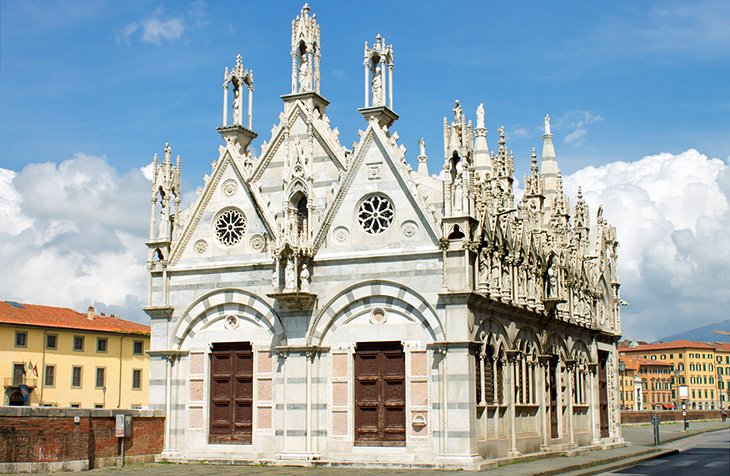
Santa Maria della Spina is a small church in the Italian city of Pisa. The church, erected around 1230 in the Pisan Gothic style, and enlarged after 1325, was originally known as Santa Maria di Pontenovo for the newer bridge that existed nearby, collapsed in the 15th century, and was never rebuilt.
The name of della Spina (“of the thorn”) derives from the presence of a thorn, putatively part of the crown of thorns placed on Christ during his Passion and Crucifixion. The relic was brought to this church in 1333. In 1871 the church was dismantled and rebuilt on a higher level due to dangerous infiltration of water from the Arno river. The church was altered in the process, however, and John Ruskin, who visited Pisa in 1872, was outraged about the restoration. The church no longer houses the “thorn”, it is now on display in the Chiesa di Santa Chiara on Via Roma.
The church of Santa Maria della Spina has always been administered by the city,except for short interruptions in the seventeenth and eighteenth centuries when it fell to the responsibility of the local hospital.
The Church of Santa Maria della Spina, on the left bank of the Arno, is perhaps the best known of Pisa’s smaller churches and certainly one of its loveliest. Originally a small oratory sitting right on the river, it suffered severe foundation damage, and in 1871 it was pulled down stone by stone and rebuilt higher up.
The richly ornate Gothic church owes its name to its possession of a thorn (spina) from Christ’s crown of thorns, brought to Pisa from the Holy Land. The west front has two doorways and three distinctive gables, each with a small rose window. On the south side of the church, a series of arches enclose doorways and windows, and higher up, a niche with figures of Christ and the Apostles.









